Tension Capacity of Crushed Limestone–Cement Grout
Abstract
:1. Introduction
2. Materials and Methods
2.1. Materials
2.2. Mixture Preparation
2.3. Specimen Preparation
2.4. Testing Procedure
3. Results and Discussion
3.1. Compressive Strength over Examined Curing Periods
3.2. Plots of Load vs. Deformation
3.3. Modulus of Elasticity (E)
3.4. Modes of Failure
4. Discussion
5. Conclusions
Author Contributions
Funding
Institutional Review Board Statement
Informed Consent Statement
Data Availability Statement
Acknowledgments
Conflicts of Interest
References
- Lankard, D.R.; Thompson, N.; Sprinkel, M.M.; Virmani, Y.P. Grouts for bonded post-tensioned concrete construction: Protecting prestressing steel from corrosion. Mater. J. 1993, 90, 406–414. [Google Scholar]
- Dong, H.-L.; Zhou, W.; Wang, Z. Flexural performance of concrete beams reinforced with FRP bars grouted in corrugated sleeves. Compos. Struct. 2019, 215, 49–59. [Google Scholar] [CrossRef]
- Müller, U.; Miccoli, L.; Fontana, P. Development of a lime based grout for cracks repair in earthen constructions. Constr. Build. Mater. 2016, 110, 323–332. [Google Scholar] [CrossRef]
- Alnuaim, A.; Abbas, Y.M.; Khan, M.I. Sustainable Application of Processed TBM Excavated Rock Material as Green Structural Concrete Aggregate. Constr. Build. Mater. 2021, 274, 121245. [Google Scholar] [CrossRef]
- Alnuaim, A.; Dafalla, M.; Al-Mahbashi, A. Enhancement of Clay–Sand Liners Using Crushed Limestone Powder for Better Fluid Control. Arab. J. Sci. Eng. 2019, 45, 367–380. [Google Scholar] [CrossRef]
- Dafalla, M.; Al-Mahbashi, A.; Alnuaim, A. Characterization and assessment of crushed limestone powder and its environmental applications. IOP Conf. Ser. Earth Environ. Sci. 2021, 727, 012013. [Google Scholar] [CrossRef]
- El-Kelesh, A.M.; Matsui, T. Compaction Grouting and Soil Compressibility. In Proceedings of the Twelfth International Offshore and Polar Engineering Conference, Kitakyushu, Japan, 26–31 May 2002. [Google Scholar]
- Bayer, I.R. Use of Preplaced Aggregate Concrete for Mass Concrete Application. Master’s Thesis, The Graduate School of Natural and Applied Sciences of Middle East Technical University, Ankara, Türkiye, 2004. [Google Scholar]
- Lothenbach, B.; Le Saout, G.; Gallucci, E.; Scrivener, K. Influence of limestone on the hydration of Portland cements. Cem. Concr. Res. 2008, 38, 848–860. [Google Scholar] [CrossRef]
- Aquino, C.; Inoue, M.; Miura, H.; Mizuta, M.; Okamoto, T. The effects of limestone aggregate on concrete properties. Constr. Build. Mater. 2010, 24, 2363–2368. [Google Scholar] [CrossRef]
- Alshahwany, R.B.A. Effect of partial replacement of sand with limestone filler on some properties of normal concrete. AL-Rafdain Eng. J. (AREJ) 2011, 19, 37–48. [Google Scholar] [CrossRef]
- Woodward, R.J.; Miller, E.J. Grouting post-tensioned concrete bridges: The prevention of voids. Highw. Transp. 1990, 37, 9–17. [Google Scholar]
- Shannag, M. High-performance cementitious grouts for structural repair. Cem. Concr. Res. 2002, 32, 803–808. [Google Scholar] [CrossRef]
- Zhang, B.; Gao, F.; Zhang, X.; Zhou, Y.; Hu, B.; Song, H. Modified cement-sodium silicate material and grouting technology for repairing underground concrete structure cracks. Arab. J. Geosci. 2019, 12, 680. [Google Scholar] [CrossRef]
- Makhloufi, Z.; Bouziani, T.; Bederina, M.; Hadjoudja, M. Mix proportioning and performance of a crushed limestone sand-concrete. J. Build. Mater. Struct. 2014, 1, 10–22. [Google Scholar] [CrossRef]
- Bonavetti, V.; Donza, H.; Menéndez, G.; Cabrera, O.; Irassar, E. Limestone filler cement in low w/c concrete: A rational use of energy. Cem. Concr. Res. 2003, 33, 865–871. [Google Scholar] [CrossRef]
- Wang, D.; Shi, C.; Farzadnia, N.; Shi, Z.; Jia, H. A review on effects of limestone powder on the properties of concrete. Constr. Build. Mater. 2018, 192, 153–166. [Google Scholar] [CrossRef]
- Daoud, O.M.A.; Mahgoub, O.S. Effect of limestone powder on self-compacting concrete. FES J. Eng. Sci. 2021, 9, 71–78. [Google Scholar] [CrossRef]
- Valcuende, M.; Marco, E.; Parra, C.; Serna, P. Influence of limestone filler and viscosity-modifying admixture on the shrinkage of self-compacting concrete. Cem. Concr. Res. 2012, 42, 583–592. [Google Scholar] [CrossRef]
- Singh, J.; Mukherjee, A.; Dhiman, V.K. Deepmala Impact of crushed limestone dust on concrete’s properties. Mater. Today Proc. 2021, 43 Pt 1, 341–347. [Google Scholar] [CrossRef]
- ASTM D2487-17; Standard Practice for Classification of Soils for Engineering Purposes (Unified Soil Classification System). ASTM International: West Conshohocken, PA, USA, 2017. [CrossRef]
- Al-Mahbashi, A.M.; Dafalla, M. Shear strength prediction for an unsaturated Sand Clay Liner. Int. J. Geotech. Eng. 2022, 16, 282–292. [Google Scholar] [CrossRef]
- Alokili, T.; Dafalla, M.; Al-Mahbashi, A.; Alnuaim, A.; Mutaz, E. Tunnel Boring Machine Crushed Limestone as a Cement Grout. In Proceedings of the Geo-Congress 2023, Los Angeles, CA, USA, 26–29 March 2023. [Google Scholar]
- ASTM D3148-96; Standard test for elastic moduli of intact rock core specimens in uniaxial compression. ASTM International: West Conshohocken, PA, USA, 1996.
- ASTM C496/C496M-17; Standard Test Method for Splitting Tensile Strength of Cylindrical Concrete Specimens. ASTM International: West Conshohocken, PA, USA, 2017.
- ASTM D3967-16; Standard Test Method for Splitting Tensile Strength of Intact Rock Core Specimens. ASTM International: West Conshohocken, PA, USA, 2016.
- Hazrati Aghchai, M.; Moarefvand, P.; Salari Rad, H. On Analytic Solutions of Elastic Net Displacements around a Circular Tunnel. J. Min. Environ. (JME) 2020, 11, 419–432. [Google Scholar] [CrossRef]
- Nicksiar, M.; Martin, C.D. Evaluation of Methods for Determining Crack Initiation in Compression Tests on Low-Porosity Rocks. Rock Mech. Rock Eng. 2012, 45, 607–617. [Google Scholar] [CrossRef]
- Wen, T.; Tang, H.; Ma, J.; Wang, Y. Evaluation of methods for determining crack initiation stress under Compression. Eng. Geol. 2018, 235, 81–97. [Google Scholar] [CrossRef]
- Mutaz, E.; Serati, M.; Williams, D.J. Crack Initiation Evolution Under Triaxial Loading Conditions. IOP Conf. Ser. Earth Environ. Sci. 2021, 833, 012012. [Google Scholar] [CrossRef]
- Lajtai, E. Brittle fracture in compression. Int. J. Fract. 1974, 10, 525–536. [Google Scholar] [CrossRef]
- Levy, S.M. Construction Calculations Manual; Elsevier: Amsterdam, The Netherlands, 2012; ISBN 978-0-12-382243-7. [Google Scholar] [CrossRef]
- Abdelgader, H.S.; Elgalhud, A.A. Effect of grout proportions on strength of two-stage concrete. Struct. Concr. 2008, 9, 163–170. [Google Scholar] [CrossRef]
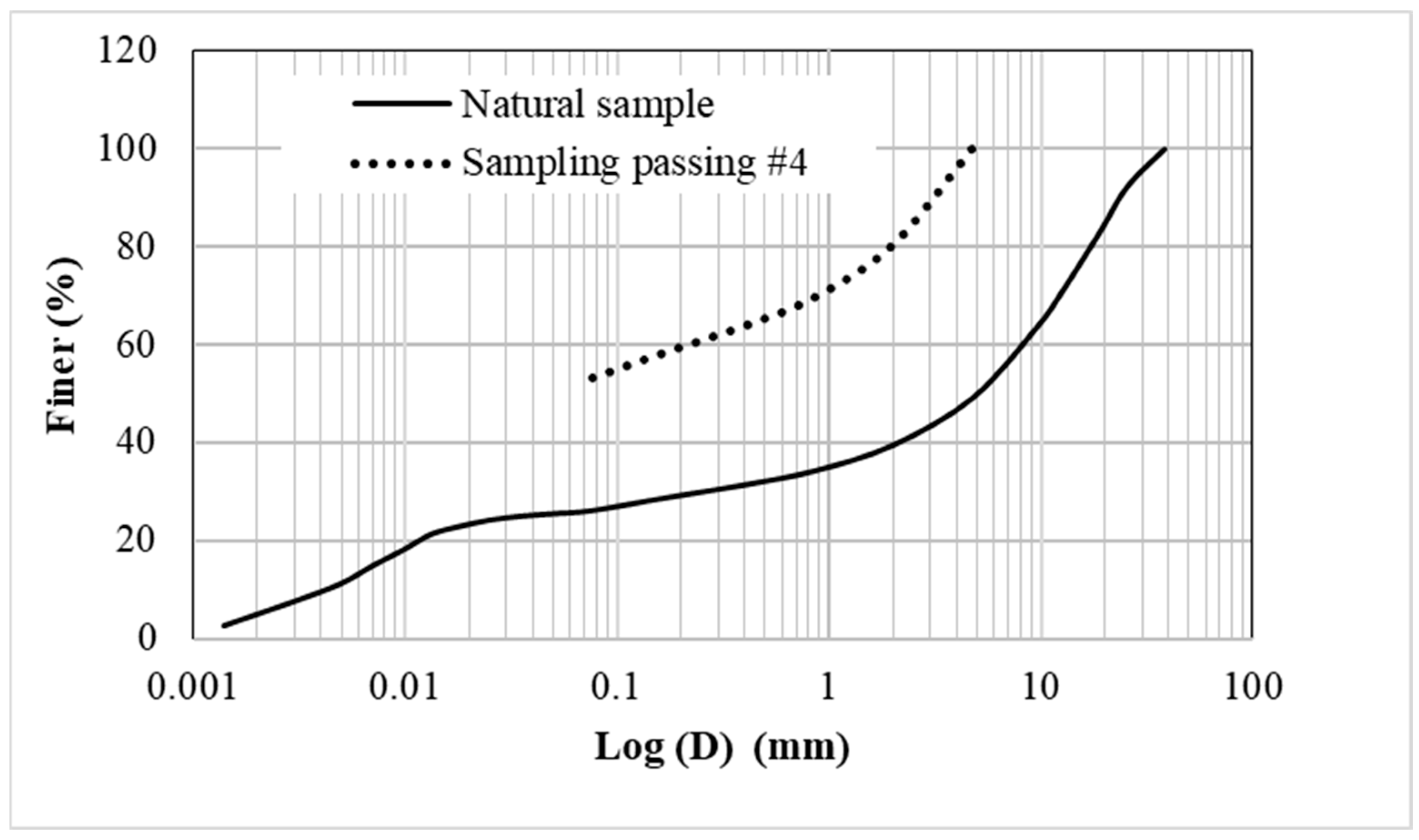

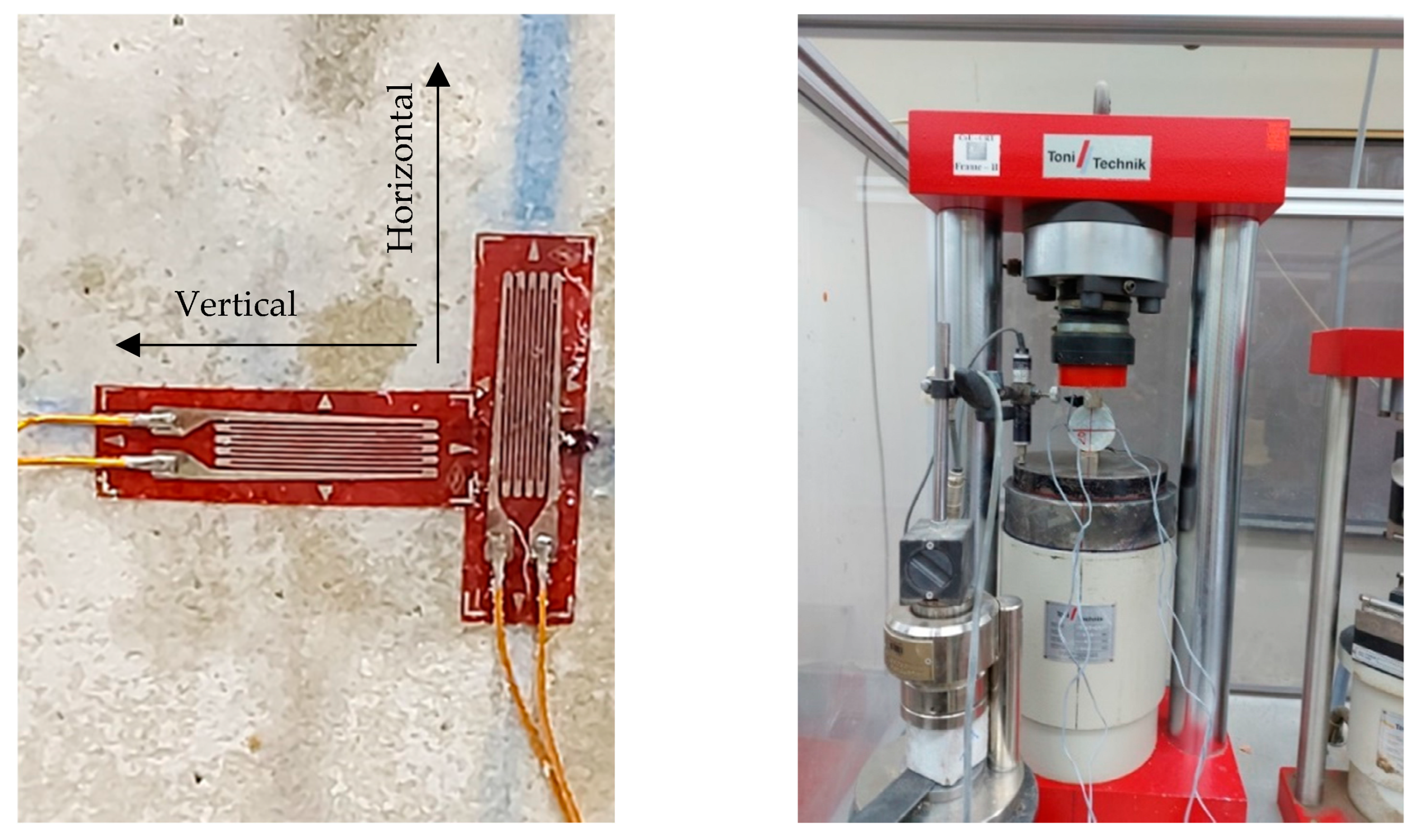
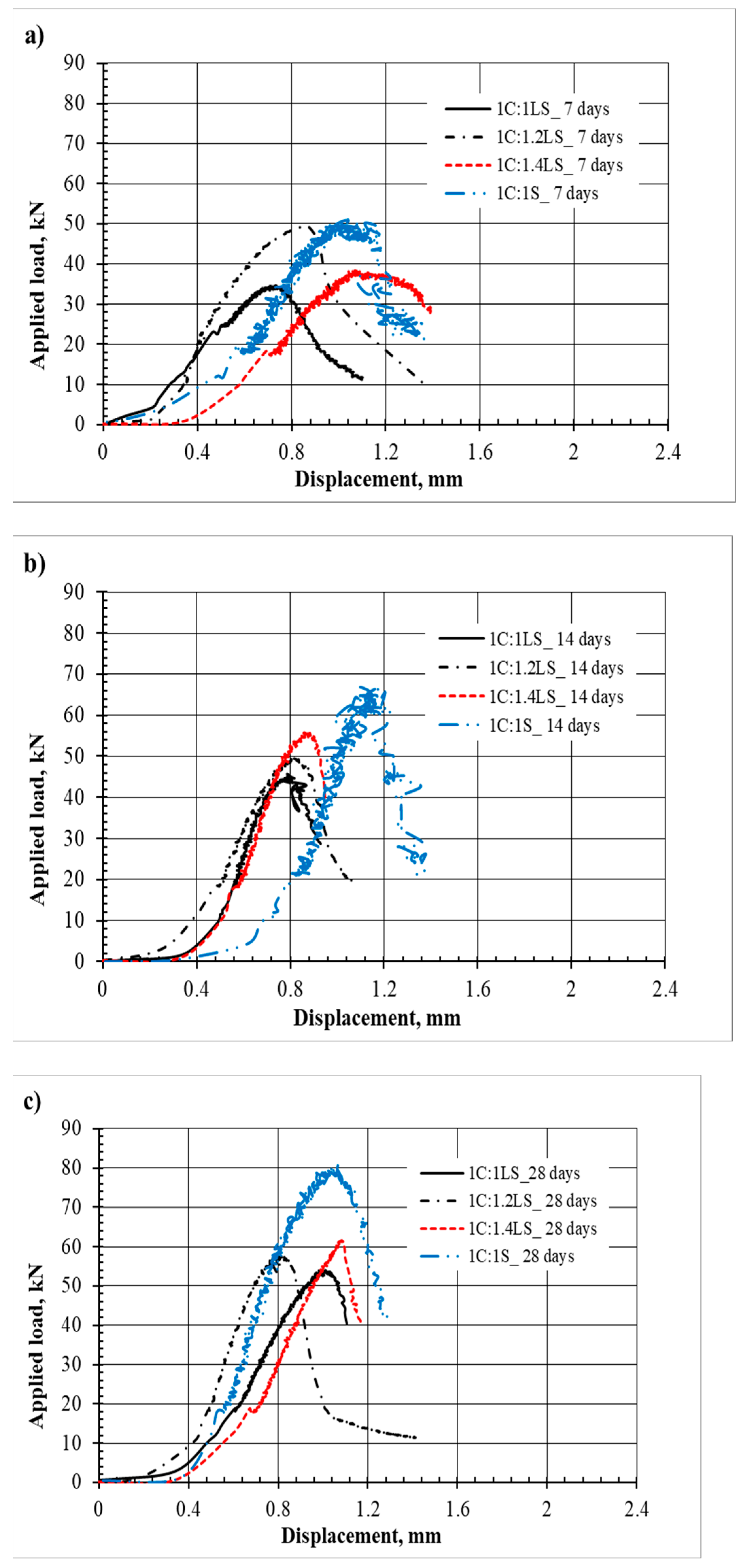
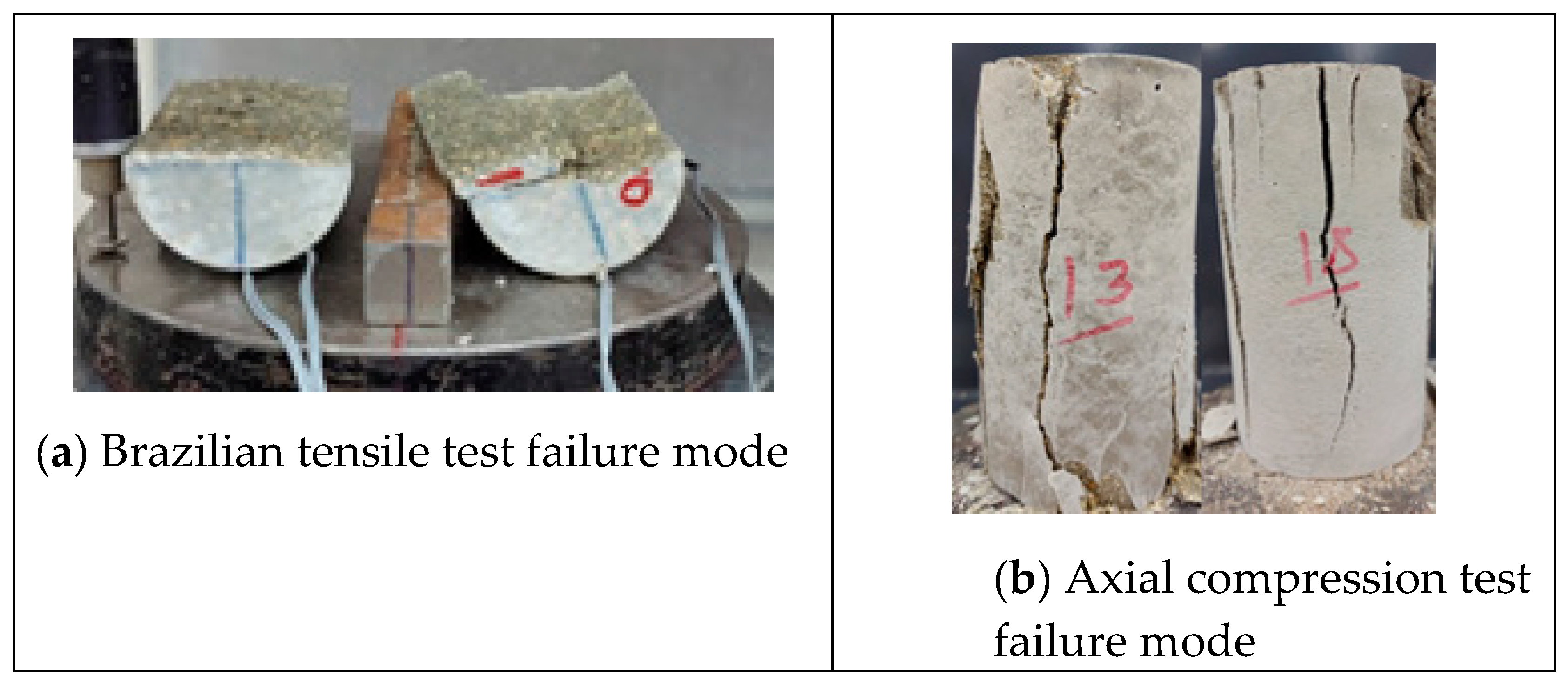

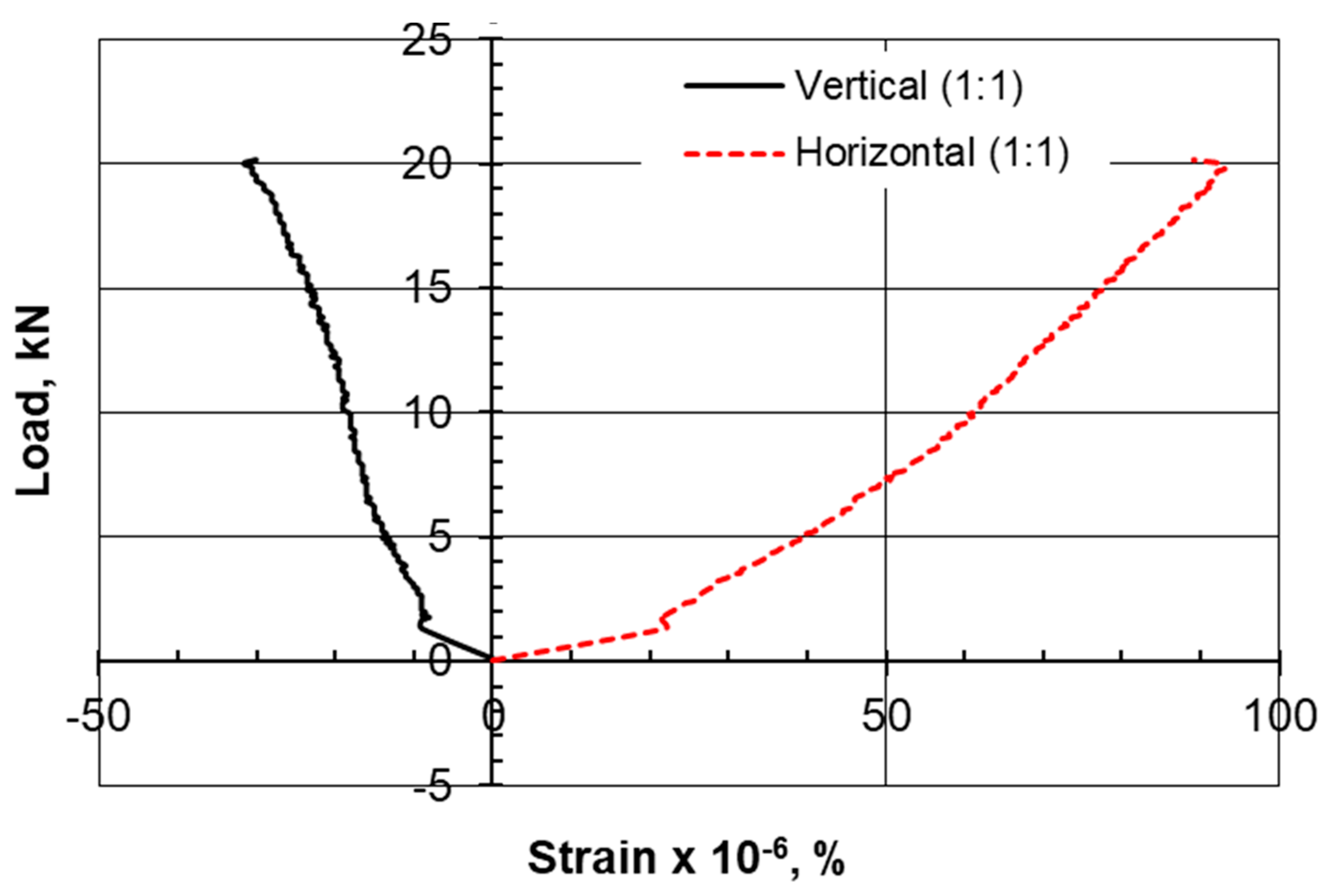


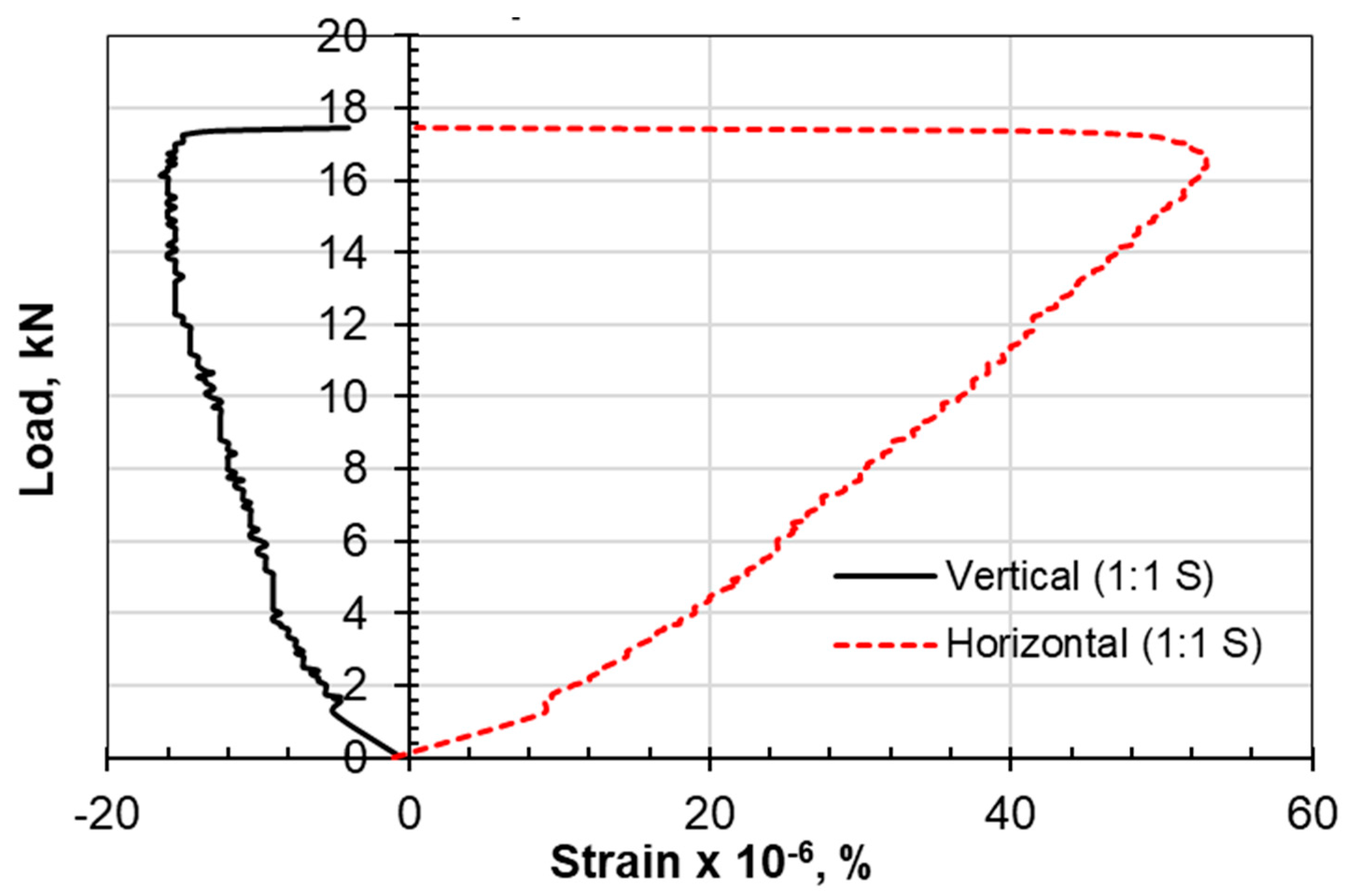
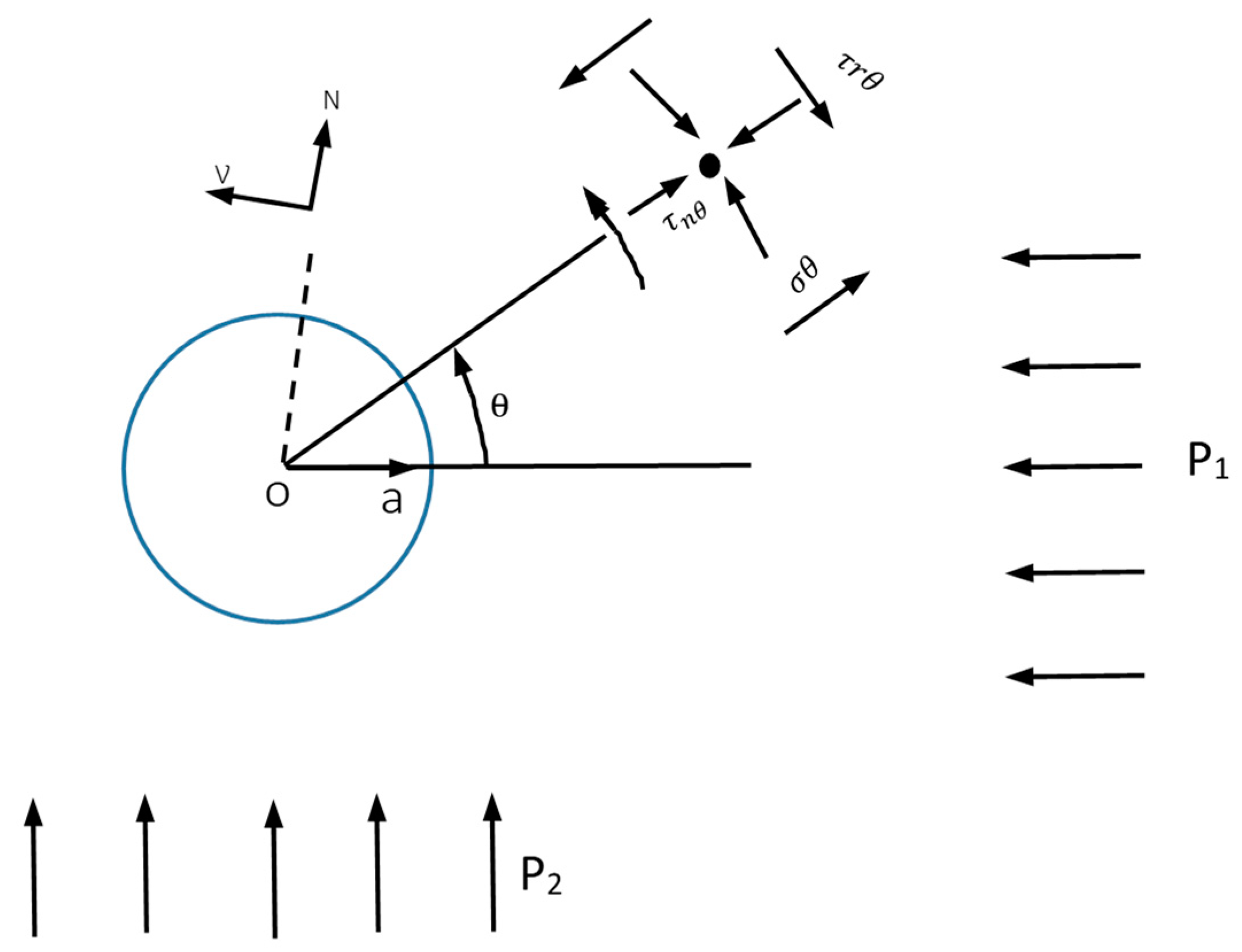
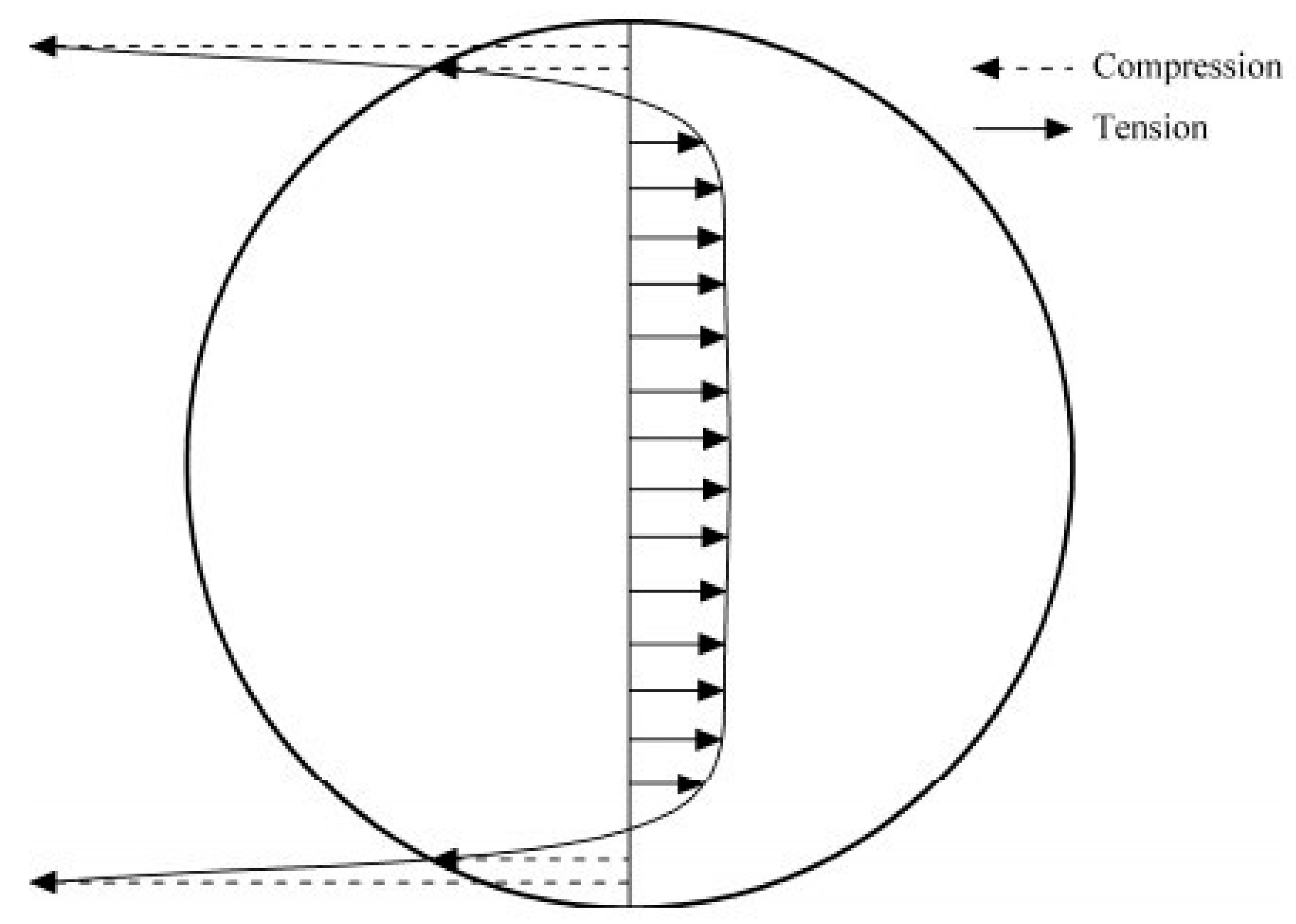
| Mixture No. | 1 | 2 | 3 | 4 | |
|---|---|---|---|---|---|
| Material ratio | Cement, C | 1 | 1 | 1 | 1 |
| Limestone, LS | 1 | 1.2 | 1.4 | - | |
| Sand, S | - | - | - | 1 | |
| Water/cement ratio | 0.6 | 0.6 | 0.6 | 0.6 * | |
| Specimens | Curing period (days) | 7 | 7 | 7 | 7 |
| 14 | 14 | 14 | 14 | ||
| 28 | 28 | 28 | 28 | ||
| Specimens | 1 | 2 | 3 | 4 | |
|---|---|---|---|---|---|
| Material portions | Cement, C | 1 | 1 | 1 | 1 |
| Limestone, LS | 1 | 1.2 | 1.4 | - | |
| Sand, S | - | - | - | 1 | |
| Curing in days | 7 | 16.620 | 23.710 | 18.320 | 24.940 |
| 14 | 21.980 | 24.090 | 26.870 | 32.440 | |
| 28 | 25.970 | 28.130 | 30.050 | 39.140 | |
| Mixture | Secant Modulus of Elasticity (Esecant) GPa | Average Modulus of Elasticity (Eavg) GPa | ||||
|---|---|---|---|---|---|---|
| Curing Days | Curing Days | |||||
| 7 | 14 | 28 | 7 | 14 | 28 | |
| 1C:1LS | 22.59 | 31.34 | 27.36 | 32.50 | 27.27 | 29.45 |
| 1C:1.2LS | 47.72 | 23.73 | 33.70 | 30.56 | 33.09 | 21.09 |
| 1C:1.4LS | 22.22 | 43.75 | 33.59 | 22.43 | 32.50 | 27.73 |
| 1C:1S | 20.31 | 32.44 | 57.20 | 17.43 | 44.44 | 57.14 |
| Mixture | (1C:1 LS) | (1C:1.2 LS) | (1C:1.4 LS) | (1C:1 Sand) |
|---|---|---|---|---|
| Max load kN | 20.15 | 17.81 | 18.63 | 17.46 |
| Spt N/mm2 | 2.54 | 2.27 | 2.38 | 2.29 |
| Stage of Loading Relative to Failure Load (20.15 kN) | Vertical Strain εv (10−6) | Horizontal Strain εh (10−6) | Horizontal/Vertical Strain Ratio εh/εv |
|---|---|---|---|
| 25% | −15 | 40 | 2.67 |
| 50% | −20 | 62 | 3.1 |
| 75% | −25 | 80 | 3.2 |
| 100% | −30 | 90 | 3.75 |
| Stage of Loading Relative to Failure Load (17.81 kN) | Vertical Strain εv (10−6) | Horizontal Strain εh (10−6) | Horizontal/Vertical Strain Ratio εh/εv |
|---|---|---|---|
| 25% | −10 | 38 | 3.8 |
| 50% | −20 | 85 | 4.25 |
| 75% | −35 | - | Failure range |
| 100% | −37 | - | Failure range |
| Stage of Loading Relative to Failure Load (18.63 kN) | Vertical Strain εv (10−6) | Horizontal Strain εh (10−6) | Horizontal/Vertical Strain Ratio εh/εv |
|---|---|---|---|
| 25% | −25 | 58 | 2.32 |
| 50% | −43 | 100 | 2.32 |
| 75% | −65 | 140 | 2.5 |
| 100% | - | 170 | Failure zone |
| Stage of Loading Relative to Failure Load (17.46 kN) | Vertical Strain εv (10−6) | Horizontal Strain εh (10−6) | Horizontal/Vertical Strain Ratio εh/εv |
|---|---|---|---|
| 25% | −10 | 24 | 2.40 |
| 50% | −14 | 34 | 2.42 |
| 75% | −18 | 46 | 2.55 |
| 100% | −17 | 54 | 3.20 |
Disclaimer/Publisher’s Note: The statements, opinions and data contained in all publications are solely those of the individual author(s) and contributor(s) and not of MDPI and/or the editor(s). MDPI and/or the editor(s) disclaim responsibility for any injury to people or property resulting from any ideas, methods, instructions or products referred to in the content. |
© 2024 by the authors. Licensee MDPI, Basel, Switzerland. This article is an open access article distributed under the terms and conditions of the Creative Commons Attribution (CC BY) license (https://creativecommons.org/licenses/by/4.0/).
Share and Cite
Dafalla, M.; Al-Mahbashi, A.M.; Alnuaim, A. Tension Capacity of Crushed Limestone–Cement Grout. Materials 2024, 17, 3860. https://doi.org/10.3390/ma17153860
Dafalla M, Al-Mahbashi AM, Alnuaim A. Tension Capacity of Crushed Limestone–Cement Grout. Materials. 2024; 17(15):3860. https://doi.org/10.3390/ma17153860
Chicago/Turabian StyleDafalla, Muawia, Ahmed M. Al-Mahbashi, and Ahmed Alnuaim. 2024. "Tension Capacity of Crushed Limestone–Cement Grout" Materials 17, no. 15: 3860. https://doi.org/10.3390/ma17153860






